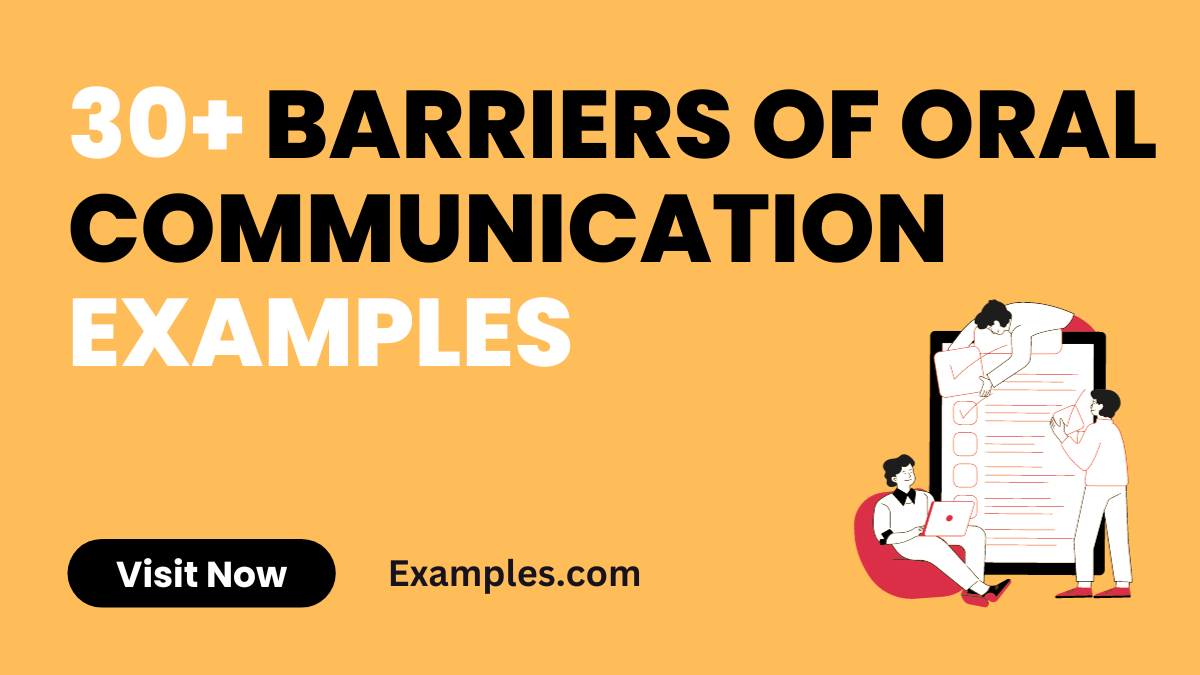29+ Barriers of Oral Communication Examples
Embark on a comprehensive exploration of Barriers of Oral Communication in our complete guide. From workplace dynamics to university settings, we unravel the intricacies, shedding light on the challenges and offering actionable solutions. Delve into this insightful resource that not only dissects the barriers but also provides communication examples for a deeper understanding. Elevate your communication skills with real-world insights and strategic tips to navigate any oral communication scenario effectively. Communication examples await to enrich your learning journey.
What are Barriers of Oral Communication?
Barriers of oral communication refer to obstacles that hinder the smooth transmission of information through spoken words. In simple terms, these are challenges that impede effective dialogue. Whether in the workplace, university, or social media, understanding these barriers is crucial for fostering clear and impactful communication. From miscommunication to differing communication styles, we delve into the essence of these obstacles, providing a clear and accessible definition for a comprehensive grasp of the subject.
30 Examples of Barriers of Oral Communication
Dive into the intricacies of communication with 30 barriers of oral communication examples. This insightful guide unveils hurdles in workplace, academic, and social settings, providing actionable insights to enhance your communication skills. From nonverbal cues to cultural differences, explore the diverse challenges hindering effective dialogue and master the art of overcoming them.
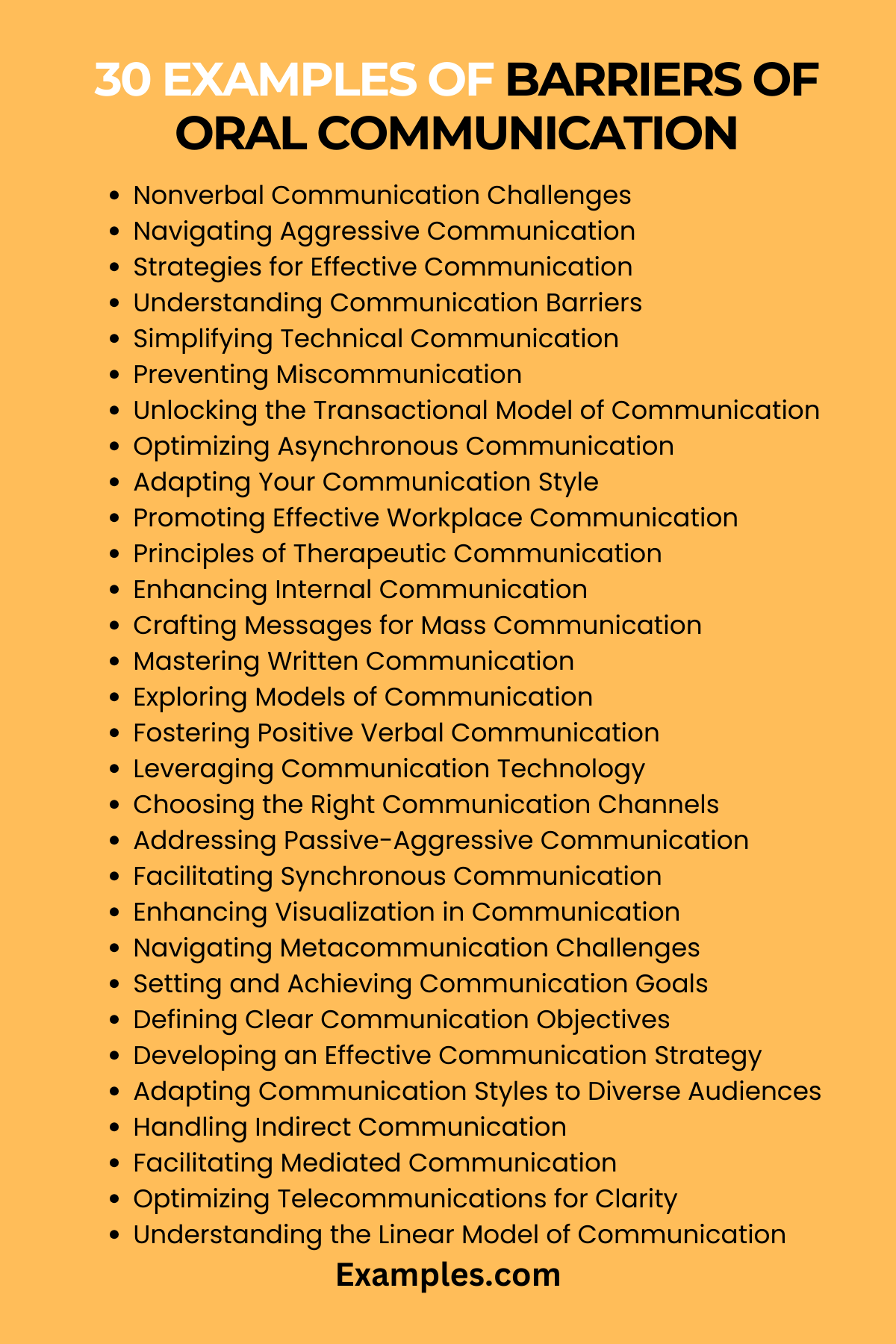
- Nonverbal Communication:
- Example: Avoiding eye contact may signal disinterest; maintain eye contact for a more engaged conversation.
- Aggressive Communication:
- Example: Replace confrontational statements with assertive ones to foster a cooperative discussion.
- Ineffective Communication:
- Example: Clearly articulate your expectations to prevent misunderstandings and ensure productive communication.
- Communication Barriers:
- Example: Use simple language to bridge language gaps and enhance cross-cultural understanding.
- Technical Communication:
- Example: Break down technical jargon for a non-expert audience, ensuring clarity in your message.
- Miscommunication:
- Example: Confirm details to avoid misinterpretation, such as verifying meeting times for clarity.
- Transactional Model of Communication:
- Example: Feedback loops are essential; ask for and provide feedback for a more dynamic communication process.
- Asynchronous Communication:
- Example: Clearly define response times in email communication to manage expectations.
- Communication Style:
- Example: Adapt your communication style to your audience, balancing formality in professional settings.
- Effective Communication in the Workplace:
- Example: Use clear directives to streamline tasks, preventing misunderstandings among team members.
- Therapeutic Communication:
- Example: Empathetic listening is key in healthcare settings to build trust with patients.
- Internal Communication:
- Example: Regular team meetings enhance internal communication, fostering a collaborative work environment.
- Mass Communication:
- Example: Tailor messages to your target audience for effective mass communication campaigns.
- Written Communication:
- Example: Craft concise and organized emails to convey messages effectively in written communication.
- Model of Communication:
- Example: Apply communication models like Shannon-Weaver to structure and refine your messages.
- Verbal Communication:
- Example: Use a calm tone in disagreements to promote a positive atmosphere in verbal communication.
- Communication Technology:
- Example: Leverage video conferencing tools for seamless communication in remote work scenarios.
- Communication Channels:
- Example: Choose appropriate channels, like face-to-face or email, based on the nature of the message.
- Passive Aggressive Communication:
- Example: Address concerns directly rather than resorting to passive-aggressive behaviour for a healthier dialogue.
- Synchronous Communication:
- Example: Real-time collaboration tools facilitate synchronous communication for immediate feedback.
- Visualization Communication:
- Example: Use visual aids in presentations to enhance understanding and engagement.
- Metacommunication:
- Example: Clarify intentions behind your words to avoid misunderstandings in metacommunication.
- Communication Goals:
- Example: Set specific communication goals, like improving team collaboration, for targeted efforts.
- Communication Objectives:
- Example: Clearly define objectives in meetings to ensure everyone is aligned on desired outcomes.
- Communication Strategy:
- Example: Develop a crisis communication strategy for swift and effective response during challenging situations.
- Communication Styles:
- Example: Adapt your communication style when dealing with diverse individuals for better resonance.
- Indirect Communication:
- Example: Clearly express your thoughts instead of relying on indirect hints to avoid confusion.
- Mediated Communication:
- Example: Use mediation techniques to facilitate resolution in conflicts for effective mediated communication.
- Telecommunications:
- Example: Utilize clear audio and video quality for seamless telecommunications in virtual meetings.
- Linear Model of Communication:
- Example: Follow the linear communication model, ensuring a logical flow of information in your presentations.
Barriers of Oral Communication at Workplace
Discover the intricacies of oral communication barriers in workplace settings. From hierarchical challenges to diverse communication styles, this guide unveils hurdles professionals face daily. Learn strategies to enhance workplace dialogue, fostering a more productive and cohesive environment.
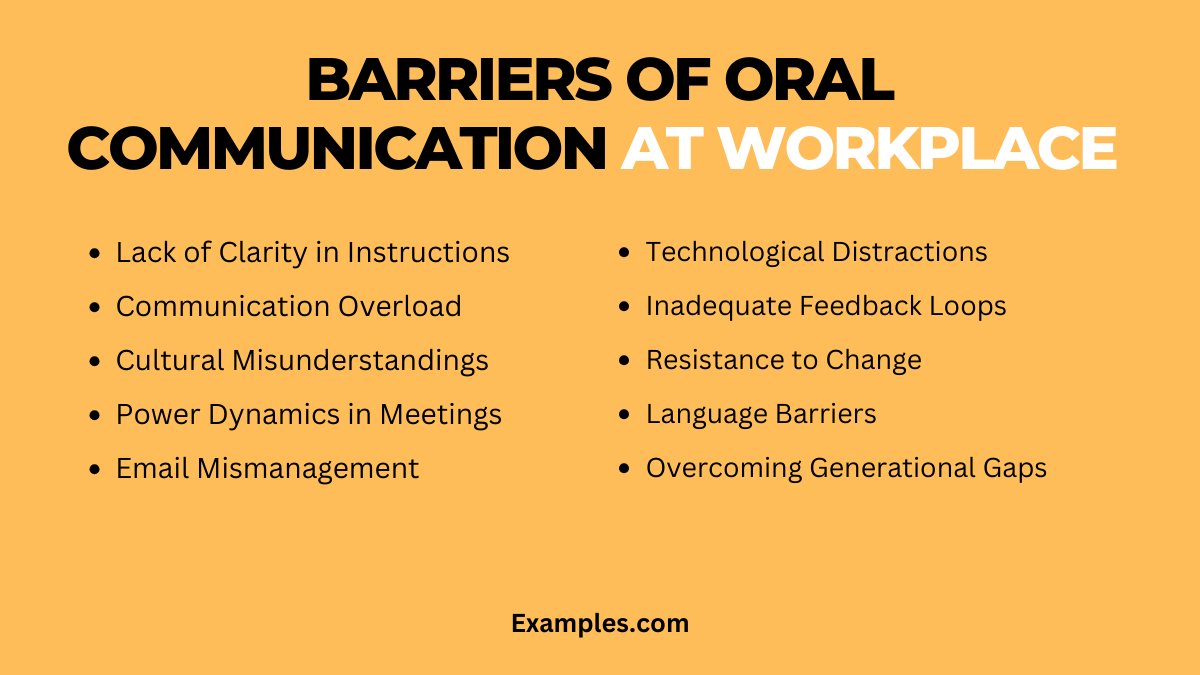
- Lack of Clarity in Instructions:
- Example: Ambiguous directives can lead to confusion; ensure clear instructions for streamlined workflow.
- Communication Overload:
- Example: Prioritize information sharing to prevent overwhelming colleagues with excessive details.
- Cultural Misunderstandings:
- Example: Embrace cultural diversity; clarify cultural nuances to avoid misinterpretations in team communication.
- Power Dynamics in Meetings:
- Example: Encourage open dialogue in meetings, ensuring all team members feel empowered to contribute.
- Email Mismanagement:
- Example: Craft concise emails; avoid information overload to enhance the effectiveness of written communication.
- Technological Distractions:
- Example: Set boundaries on device usage during meetings to minimize distractions and improve focus.
- Inadequate Feedback Loops:
- Example: Foster a culture of feedback; encourage constructive criticism for continuous improvement in communication.
- Resistance to Change:
- Example: Communicate the benefits of change; address concerns to mitigate resistance among team members.
- Language Barriers:
- Example: Promote language inclusivity; provide translation support for non-native speakers in the workplace.
- Overcoming Generational Gaps:
- Example: Bridge generational divides by fostering mentorship; facilitate knowledge transfer through effective communication.
Barriers of Oral Communication at University
Explore the challenges of oral communication in university settings, from lecture halls to group projects. Uncover effective strategies to overcome barriers, enhancing academic interactions for students and educators alike.
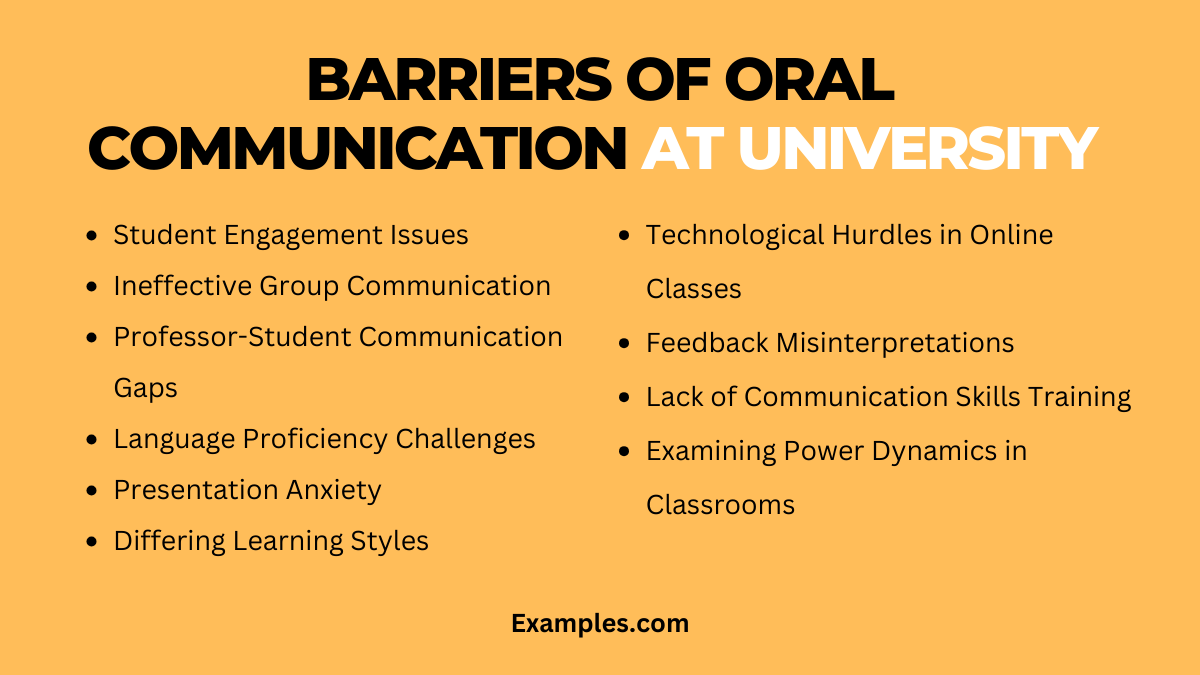
- Student Engagement Issues:
- Example: Foster inclusive discussions; encourage active participation to address student disengagement in large classes.
- Ineffective Group Communication:
- Example: Establish clear communication norms within groups; prevent misunderstandings for smoother collaboration.
- Professor-Student Communication Gaps:
- Example: Schedule regular office hours; bridge gaps between students and professors to address academic concerns.
- Language Proficiency Challenges:
- Example: Provide language support for international students; enhance inclusivity in classroom discussions.
- Presentation Anxiety:
- Example: Offer public speaking workshops; empower students to overcome anxiety for more confident presentations.
- Differing Learning Styles:
- Example: Adopt varied teaching methods; accommodate diverse learning styles to improve student comprehension.
- Technological Hurdles in Online Classes:
- Example: Provide tech support resources; minimize disruptions for students navigating online communication challenges.
- Feedback Misinterpretations:
- Example: Clarify feedback expectations; guide students in understanding and applying constructive criticism.
- Lack of Communication Skills Training:
- Example: Integrate communication skills into curricula; equip students for effective academic and professional dialogues.
- Examining Power Dynamics in Classrooms:
- Example: Cultivate an inclusive environment; promote equitable communication to empower all students in academic discussions.
What are the 4 Barriers of Oral Communication?
In the realm of oral communication, understanding and overcoming barriers is essential for effective dialogue. Explore the four key barriers that often impede clear and impactful communication.
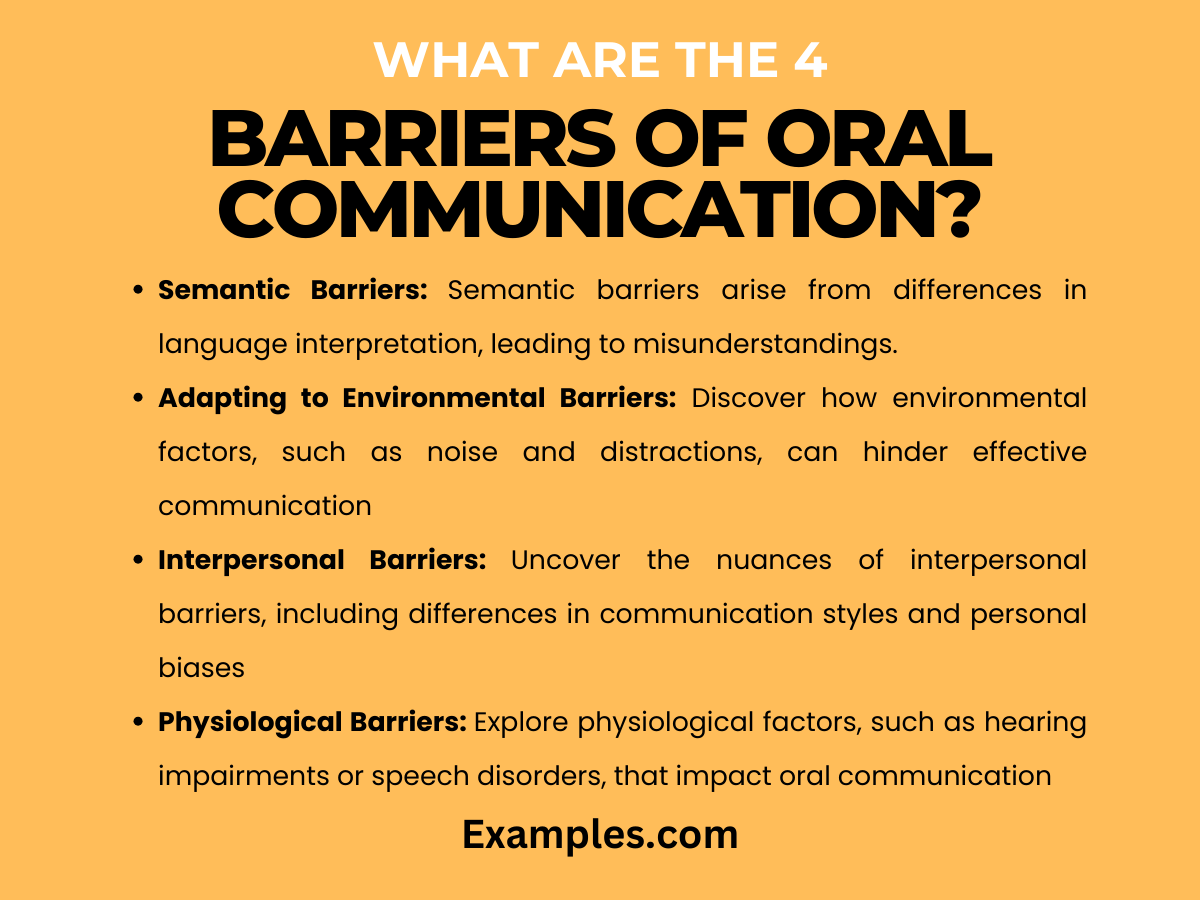
- Semantic Barriers: Semantic barriers arise from differences in language interpretation, leading to misunderstandings. Learn how to navigate these challenges and enhance clarity in oral communication.
- Environmental Barriers: Discover how environmental factors, such as noise and distractions, can hinder effective communication. Explore strategies to create communication-friendly environments in various settings.
- Interpersonal Barriers: Uncover the nuances of interpersonal barriers, including differences in communication styles and personal biases. Gain insights into fostering positive interpersonal dynamics for smoother conversations.
- Physiological Barriers: Explore physiological factors, such as hearing impairments or speech disorders, that impact oral communication. Learn inclusive communication practices to overcome these barriers and ensure everyone is heard.
What is the Most Important Barrier in Oral Communication?
Understanding the pivotal barrier in oral communication is crucial for targeted improvement. Explore the most significant factor that can impede effective dialogue and learn strategies to overcome this paramount obstacle.
- Lack of Active Listening: Active listening is the cornerstone of effective communication. Learn how the failure to truly engage with others hampers understanding and discover techniques to enhance your active listening skills.
- Misalignment of Communication Styles: Differences in communication styles can lead to confusion and frustration. Identify the importance of aligning communication styles and explore adaptive strategies for improved interactions.
- Cultural Misunderstandings: Cultural nuances play a significant role in oral communication. Explore how cultural differences can create barriers and gain insights into fostering cross-cultural understanding for smoother conversations.
- Inadequate Feedback Mechanisms: Feedback is essential for refining communication. Understand the impact of insufficient feedback and explore methods to establish robust feedback loops for continuous improvement.
In conclusion, understanding and addressing the barriers of oral communication is vital for fostering effective dialogue in various settings, including workplaces, universities, and social environments. These barriers, ranging from miscommunication to cultural differences, require not only awareness but also the implementation of actionable strategies to enhance communication skills. It’s crucial to explore and apply real-world insights and techniques to navigate these challenges successfully.
To further enrich your understanding and skills in oral communication, consider exploring additional resources. The Harvard Business Review offers a wealth of articles and insights on effective communication in the workplace, which can be found at Harvard Business Review – Communication. Additionally, for academic-oriented communication strategies, the Stanford University’s Hume Center for Writing and Speaking provides comprehensive resources and guidance, accessible at Stanford Hume Center. Both of these sources offer high-quality, relevant information that can significantly contribute to overcoming the barriers of oral communication.



